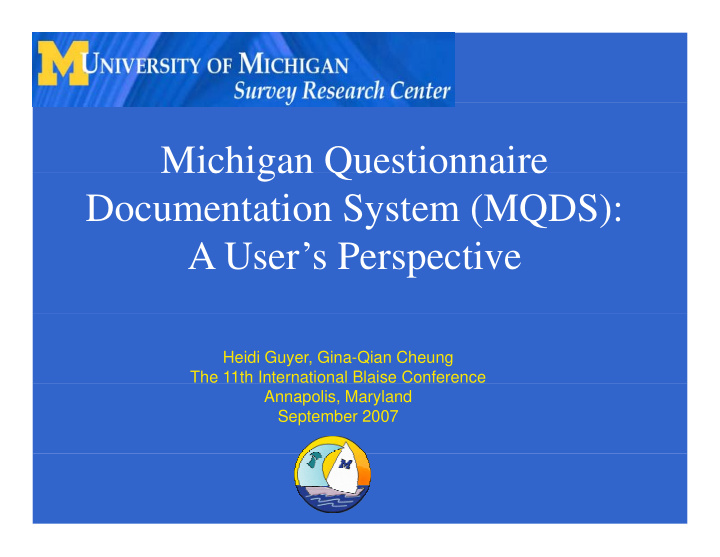



Michigan Questionnaire c ga Quest o a e Documentation System (MQDS): A U A User’s Perspective ’ P i Heidi Guyer, Gina-Qian Cheung The 11th International Blaise Conference Annapolis, Maryland September 2007
MQDS Background MQDS Background • Goal: Develop a system used to generate Goal: Develop a system used to generate questionnaires & codebooks from a Blaise data model / data set • Developed by the University of Michigan’s Survey Research Center Survey Research Center • Development Period: 2003 – 2007 • International Consortium of Users: 2006- present p
Main features of MQDS Main features of MQDS Core Tools • Questionnaire Documentation • Codebook Documentation (from Blaise BDB or ( SAS data set) Additional Tools • XML Merge • Reapply Stylesheet • Blaise to SAS • SAS to XML
Review Method Review Method • “Testing to robustness” Testing to robustness • Testing Team identified • Testing plan developed • Testing plan developed • Bug Log developed • Data models assigned D t d l i d • Group & Individual testing sessions • Solicit comments from internal users • Solicit comments from Consortium users
Overall Impressions p • Key Features y – Flexibility – Supports multiple languages – Updated interface p • Pros – Easy to install – Sample project provided – Updated and complete documentation – Format of output • Cons – Limitations with large or complex data models
Program Interface Program Interface
Questionnaire Documentation Q • Key Features – Output in RTF or HTML O t t i RTF HTML – Include hyperlinks and external lookup files • Pros – Flexibility in formatting – User selects items displayed – Supports multiple languages – Hyperlinks can be used to include other files • Cons – Some of the screens are confusing (stylesheet selection) g ( y ) – Default color of hyperlinks and interviewer instructions is the same – Inability to display logic for large or complex data models
Questionnaire Documentation Questionnaire Documentation
Questionnaire Documentation Questionnaire Documentation
Questionnaire Documentation Questionnaire Documentation English Spanish Tagalog Tagalog
Codebook • Key Features – Output in RTF or HTML – Output in RTF or HTML – Ability to generate a codebook from Blaise or SAS data set • Pros Pros – Flexibility in formatting – User selects items displayed – Supports multiple languages Supports multiple languages – Frequencies and descriptive statistics are displayed • Cons – Same usability issues as with the Questionnaire Documentation – Inability to process extremely large data sets – Tool needed to confirm that all variables are included in the output – Codeframes will not match output for recoded or newly created SAS variables
Codebook Documentation
Demonstration Demonstration
Additional Tools • XML Merge • XML Merge • Reapply Stylesheet • Blaise to SAS • SAS to XML All useful time saving tools! All useful, time-saving tools!
Additional uses of MQDS Additional uses of MQDS • Can be used throughout the project Can be used throughout the project lifecycle: – Instrument development and testing Instrument development and testing – Documentation – IRB submission IRB submission – Training – During data collection D i d t ll ti – Post-data collection
Additional uses of MQDS Additional uses of MQDS • Can be used for comparison purposes: – Across waves of a longitudinal study – Across the same study in multiple languages – Across similar studies
CPES Project CPES Project • Collaborative Psychiatric Epidemiology • Collaborative Psychiatric Epidemiology Surveys (CPES) – Three NIMH mental health surveys Th NIMH t l h lth • National Comorbidity Survey – Replication • National Survey of Latinos and Asian Americans • National Survey of Latinos and Asian Americans • National Survey of American Life
CPES Project CPES Project • Primary goals: • Primary goals: – Harmonize and merge multiple datasets – Disseminate for public use Di i t f bli
Harmonization and Disclosure Analysis • Develop survey instrument crosswalk D l i t t lk – Link sections and questions – Evaluate questions for comparability – Re-code questions and re-link if required for harmonization • Merge datasets • Perform disclosure analysis – Re-code and drop variables – Restricted use dataset will be available [soon] [ ] • Generate XML question metadata files (MQDS) – Question text, response options, missing data codes, frequencies etc frequencies, etc.
CPES Home Page Overview g www.icpsr.umich.edu/CPES
Interactive Documentation Interactive Documentation
Interactive Documentation: Frequencies / Summary Stats
Future Directions Future Directions • Investigate incorporation of Data Investigate incorporation of Data Dissemination Initiative (DDI) v.3 recommendations recommendations. • PDF output
Summary Summary • Useful tool for creating questionnaire and Useful tool for creating questionnaire and data documentation • Primary drawbacks encountered with • Primary drawbacks encountered with large, complex data sets
Acknowledgments Acknowledgments ISR-SRC-SRO Tricia Blanchard, Karl Dinkelmann, Eduardo Galván, Hemant Kannan, Peter Sparks ISR-SRC Health & Retirement Study, Panel Study of Income Dynamics Dynamics MQDS Consortium Members Mathematica Policy Research National Centre for Social Mathematica Policy Research, National Centre for Social Research, Statistics Canada, UMich Survey Research Center
Recommend
More recommend